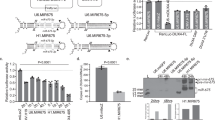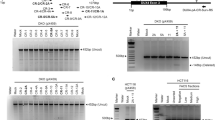Abstract
The third most common muscular dystrophy in the world, facioscapulohumeral muscular dystrophy (FSHD), is an inherited disorder characterized by distinct asymmetric, progressive skeletal muscle weakness that begins in the upper body and spreads to other regions with age. It is caused by mutations that induce aberrant expression of the DUX4 gene in skeletal muscle. DUX4 is highly cytotoxic in skeletal muscle, dysregulating numerous signaling pathways as a result of its transcription factor activity. A promising set of approaches being developed to treat FSHD uses antisense oligonucleotides (AOs) to inhibit DUX4 transcript expression. Both steric-blocking and gapmer AOs have been shown to induce efficient DUX4 transcript knockdown in vitro and in vivo. Here, we describe a protocol that allows reliable screening of DUX4-targeting AOs through the evaluation of DUX4 transcript expression by quantitative real-time polymerase chain reaction. We also describe methods to assess the efficacy of these AOs by looking at their effect on the expression of DUX4 downstream target and potential off-target genes, as well as on the amelioration of in vitro muscle cell phenotypes.
Access this chapter
Tax calculation will be finalised at checkout
Purchases are for personal use only
Similar content being viewed by others
References
Wang LH, Tawil R (2016) Facioscapulohumeral dystrophy. Curr Neurol Neurosci Rep 16:66. https://doi.org/10.1007/s11910-016-0667-0
Mah JK, Korngut L, Fiest KM et al (2016) A systematic review and meta-analysis on the epidemiology of the muscular dystrophies. Can J Neurol Sci/J Can Des Sci Neurol 43:163–177. https://doi.org/10.1017/cjn.2015.311
Klinge L, Eagle M, Haggerty ID et al (2006) Severe phenotype in infantile facioscapulohumeral muscular dystrophy. Neuromuscul Disord 16:553–558. https://doi.org/10.1016/j.nmd.2006.06.008
Goselink RJM, Voermans NC, Okkersen K et al (2017) Early onset facioscapulohumeral dystrophy – a systematic review using individual patient data. Neuromuscul Disord 27:1077–1083. https://doi.org/10.1016/j.nmd.2017.09.007
Lemmers RJLF, van der Vliet PJ, Klooster R et al (2010) A unifying genetic model for facioscapulohumeral muscular dystrophy. Science 329:1650–1653. https://doi.org/10.1126/science.1189044
Himeda CL, Jones PL (2019) The genetics and epigenetics of facioscapulohumeral muscular dystrophy. Annu Rev Genomics Hum Genet 20:265–291. https://doi.org/10.1146/annurev-genom-083118-014933
Gabriëls J, Beckers MC, Ding H et al (1999) Nucleotide sequence of the partially deleted D4Z4 locus in a patient with FSHD identifies a putative gene within each 3.3 kb element. Gene 236:25–32
Hewitt JE, Lyle R, Clark LN et al (1994) Analysis of the tandem repeat locus D4Z4 associated with facioscapulohumeral muscular dystropothhy. Hum Mol Genet 3:1287–1295. https://doi.org/10.1093/hmg/3.8.1287
Lemmers RJLF, de Kievit P, Sandkuijl L et al (2002) Facioscapulohumeral muscular dystrophy is uniquely associated with one of the two variants of the 4q subtelomere. Nat Genet 32:235–236. https://doi.org/10.1038/ng999
Hewitt JE (2015) Loss of epigenetic silencing of the DUX4 transcription factor gene in facioscapulohumeral muscular dystrophy: figure 1. Hum Mol Genet 24:R17–23. https://doi.org/10.1093/hmg/ddv237
van Overveld PGM, Lemmers RJFL, Sandkuijl LA et al (2003) Hypomethylation of D4Z4 in 4q-linked and non-4q-linked facioscapulohumeral muscular dystrophy. Nat Genet 35:315–317. https://doi.org/10.1038/ng1262
Lemmers RJLF, Tawil R, Petek LM et al (2012) Digenic inheritance of an SMCHD1 mutation and an FSHD-permissive D4Z4 allele causes facioscapulohumeral muscular dystrophy type 2. Nat Genet 44:1370–1374. https://doi.org/10.1038/ng.2454
van den Boogaard ML, Lemmers RJLF, Balog J et al (2016) Mutations in DNMT3B modify epigenetic repression of the D4Z4 repeat and the penetrance of facioscapulohumeral dystrophy. Am J Hum Genet 98:1020–1029. https://doi.org/10.1016/j.ajhg.2016.03.013
Hamanaka K, Šikrová D, Mitsuhashi S et al (2020) Homozygous nonsense variant in LRIF1 associated with facioscapulohumeral muscular dystrophy. Neurology 94:e2441–e2447. https://doi.org/10.1212/WNL.0000000000009617
Lim KRQKRQ, Nguyen Q, Yokota T (2020) DUX4 signalling in the pathogenesis of facioscapulohumeral muscular dystrophy. Int J Mol Sci 21:729. https://doi.org/10.3390/ijms21030729
Lim KRQ, Yokota T (2021) Genetic approaches for the treatment of facioscapulohumeral muscular dystrophy. Front Pharmacol 12:642858. https://doi.org/10.3389/fphar.2021.642858
Vanderplanck C, Ansseau E, Charron S et al (2011) The FSHD atrophic myotube phenotype is caused by DUX4 expression. PLoS One 6:e26820. https://doi.org/10.1371/journal.pone.0026820
Marsollier A-C, Ciszewski L, Mariot V et al (2016) Antisense targeting of 3′ end elements involved in DUX4 mRNA processing is an efficient therapeutic strategy for facioscapulohumeral dystrophy: a new gene-silencing approach. Hum Mol Genet 25:1468–1478. https://doi.org/10.1093/hmg/ddw015
Chen JC, King OD, Zhang Y et al (2016) Morpholino-mediated knockdown of DUX4 toward facioscapulohumeral muscular dystrophy therapeutics. Mol Ther 24:1405–1411. https://doi.org/10.1038/mt.2016.111
Ansseau E, Vanderplanck C, Wauters A et al (2017) Antisense oligonucleotides used to target the DUX4 mRNA as therapeutic approaches in faciosscapulohumeral muscular dystrophy (FSHD). Genes (Basel) 8:93. https://doi.org/10.3390/genes8030093
Lim KRQ, Yokota T (2020) Invention and early history of gapmers. In: Yokota T, Maruyama R (eds) Gapmers methods protoc. Springer, pp 3–19
Lim KRQ, Maruyama R, Echigoya Y et al (2020) Inhibition of DUX4 expression with antisense LNA gapmers as a therapy for facioscapulohumeral muscular dystrophy. Proc Natl Acad Sci 117:16509–16515. https://doi.org/10.1073/pnas.1909649117
Lim KRQ, Bittel A, Maruyama R et al (2020) DUX4 transcript knockdown with antisense 2′-o-methoxyethyl gapmers for the treatment of facioscapulohumeral muscular dystrophy. Mol Ther. https://doi.org/10.1016/j.ymthe.2020.10.010
Snider L, Geng LN, Lemmers RJLF et al (2010) Facioscapulohumeral dystrophy: incomplete suppression of a retrotransposed gene. PLoS Genet 6:e1001181. https://doi.org/10.1371/journal.pgen.1001181
Tassin A, Laoudj-Chenivesse D, Vanderplanck C et al (2013) DUX4 expression in FSHD muscle cells: how could such a rare protein cause a myopathy? J Cell Mol Med 17:76–89. https://doi.org/10.1111/j.1582-4934.2012.01647.x
Pandey SN, Khawaja H, Chen Y-W (2015) Culture conditions affect expression of DUX4 in FSHD myoblasts. Molecules 20:8304–8315. https://doi.org/10.3390/molecules20058304
Block GJ, Narayanan D, Amell AM et al (2013) Wnt/β-catenin signaling suppresses DUX4 expression and prevents apoptosis of FSHD muscle cells. Hum Mol Genet 22:4661–4672. https://doi.org/10.1093/hmg/ddt314
Stadler G, Chen JCJ, Wagner K et al (2011) Establishment of clonal myogenic cell lines from severely affected dystrophic muscles – CDK4 maintains the myogenic population. Skelet Muscle 1:12. https://doi.org/10.1186/2044-5040-1-12
Acknowledgments
This work was supported by the Friends of Garrett Cumming Research & Muscular Dystrophy Canada HM Toupin Neurological Science Research Chair Fund, Muscular Dystrophy Canada (853669), Canadian Institutes of Health Research (PS 175261), University Hospital Foundation, Women and Children’s Health Research Institute (3279), and the Alberta Innovates Graduate Studentship.
Author information
Authors and Affiliations
Corresponding author
Editor information
Editors and Affiliations
Rights and permissions
Copyright information
© 2023 The Author(s), under exclusive license to Springer Science+Business Media, LLC, part of Springer Nature
About this protocol
Cite this protocol
Lim, K.R.Q., Yokota, T. (2023). Knocking Down DUX4 in Immortalized Facioscapulohumeral Muscular Dystrophy Patient-Derived Muscle Cells. In: Maruyama, R., Yokota, T. (eds) Muscular Dystrophy Therapeutics. Methods in Molecular Biology, vol 2587. Humana, New York, NY. https://doi.org/10.1007/978-1-0716-2772-3_12
Download citation
DOI: https://doi.org/10.1007/978-1-0716-2772-3_12
Published:
Publisher Name: Humana, New York, NY
Print ISBN: 978-1-0716-2771-6
Online ISBN: 978-1-0716-2772-3
eBook Packages: Springer Protocols




